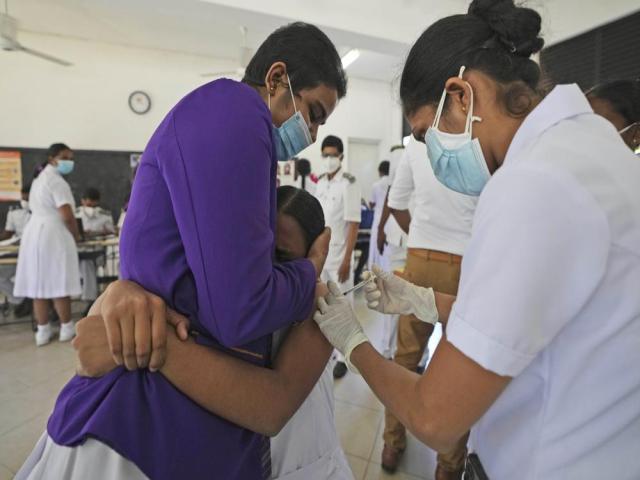Sri Lankan health authorities on Friday began vaccinating children aged 12 to 15

Sri Lankan health authorities on Friday began vaccinating children aged 12 to 15, as the island nation’s top medical specialists warned of a wave of COVID-19 infections in the coming weeks driven by the omicron variant.
Under the new vaccination program, children will be given a single dose of the Pfizer vaccine, said the health ministry. Earlier, children above 15 could be vaccinated.
Japanese Prime Minister Fumio Kishida said Sunday that Japan and the U.S. have reached “a basic agreement” on banning the U.S. military from leaving its base grounds, amid growing worries about a sharp rise in coronavirus cases.
Kishida said American soldiers will stay on base “except when absolutely necessary,” which presumably means for emergencies or other security reasons. Details of the deal are still being worked out, he said on Fuji TV. The overall U.S.-Japan security alliance remains unchanged.
New daily COVID-19 cases have surged recently in what medical experts call “the sixth wave.” New cases jumped above 8,000 on Saturday, a four-month record. The spike has been blamed on the U.S. military because the case increases are most pronounced in areas near the bases. Japan asked the U.S. for cooperation in keeping its military personnel on base last week.
The latest effort begins as schools are set to fully reopen from Monday. Children were previously allowed to attend schools in two groups.
The move also comes as authorities take steps to make vaccination certificates compulsory to enter public places.
According to health officials, 47 omicron cases have been detected so far in Sri Lanka.
The Association of Medical Specialists, which comprises the country’s top doctors, pointed to a surge in COVID-19 cases last April as a warning “that history is repeating itself.”
Almost 15,000 people died in that outbreak.
“Shops and bars, (New Year’s Eve) parties were jampacked,” the association said in a statement. “It is therefore inevitable that the omicron variant will cause a massive wave of infection during the coming weeks.”
Last April’s surge led to two separate lockdowns. The latest lockdown was lifted in October and authorities have since gradually relaxed many COVID-related restrictions.
At the peak last July, Sri Lanka reported more than 3,000 daily infections and more than 200 deaths. Daily infections are now around 500, with fewer than 20 deaths.
The country has recorded 589,479 total confirmed cases and 15,065 deaths.
Life in Sri Lanka has begun returning to normal with the partial lifting of restrictions on restaurants, supermarkets, cinemas and weddings. But authorities have maintained strict restrictions on public transport and they discourage public gatherings.
Face masks and social distancing in public are still mandatory and police take legal action against anyone who fails to comply.
Nearly 64% of Sri Lanka’s 22 million people have been fully vaccinated, and about 20% have received boosters.
Australia’s most populous state reinstated some restrictions and suspended elective surgeries on Friday as COVID-19 cases surged to another record.
New South Wales reported 38,625 new cases, prompting Premier Dominic Perrottet to announce regulations banning dancing and singing in pubs and nightclubs, and delaying non-urgent surgeries until mid-February.
Hospitalizations reached 1,738 in the state on Friday and health authorities warned that the number could spike to 4,700 or even 6,000 in a worst-case scenario within the next month. Hospitals already are under strain as around 3,800 medical professionals are in isolation after testing positive for COVID-19.
Perrottet acknowledged “it has been an incredibly challenging two years” but said the reintroduction of the protocols was “sensible and proportionate.”
The head of the Australian Medical Association criticized Perrottet on Friday, saying the spike in case numbers and hospitalizations resulted from his decision to relax restrictions just as the omicron variant began to surge in the state.
“It’s going to take some weeks to reach this peak and therefore we just have to brace ourselves,” Khorshid added.
Deputy health secretary Susan Pearce predicted that New South Wales would be over the worst of the omicron surge by the middle of next month.
“Overseas experiences have shown that this will rise quickly and pass quickly,” Pearce told reporters. “We believe by the middle of February we will be certainly well past the peak of this.”
The broader COVID-19 picture was similar across Australia on Friday with record case numbers in most states. More than 76,000 new cases were recorded nationwide, with more than 3,600 people in hospitals, including 223 in intensive care.
Victoria state, where tennis star Novak Djokovic was spending his second day in quarantine, reported 21,728 cases and will introduce new rules requiring anyone with a positive rapid antigen test to isolate and inform close contacts.
Queensland reported 10,953 cases as Premier Annastacia Palaszczuk encouraged people to work from home if possible.

Wary of a New Strain of Covid-19 which Has the infectiousness Faster
- Wary of a New Strain of Covid-19 which Has the infectiousness Faster

China locks down 3rd city, raising affected to 20 million
- A third Chinese city has locked down its residents because of a COVID-19 outbreak, raising the number confined to their homes in China to about

What Is EMDR? The ‘Bizarre’ Therapy Helping Prince Harry Heal
- The therapy has decades of clinical evidence to support that it can be remarkably successful for treating PTSD, which is often marked by terrifying flashbacks

Amazing Benefits And Uses of Quinoa For Humans
- So, behind the word "quinoa" (or "quinoa" is the correct name, the options are also used: "rice quinoa", "Peruvian rice", "quinoa")